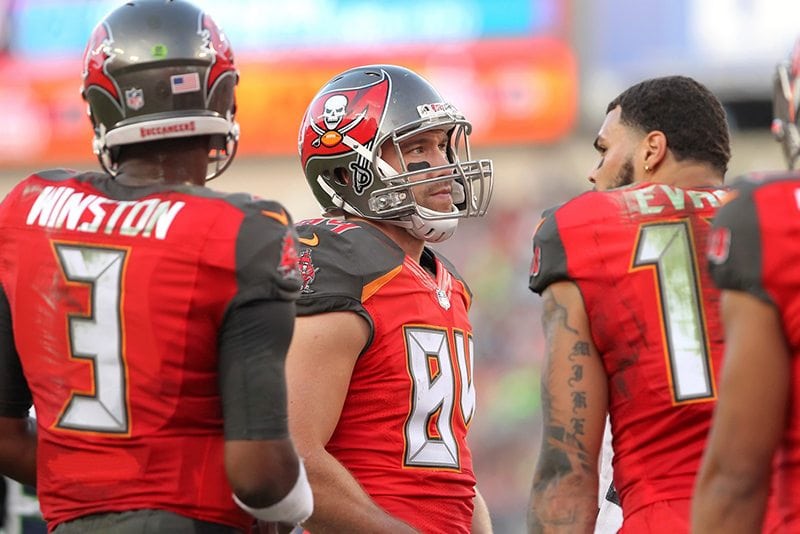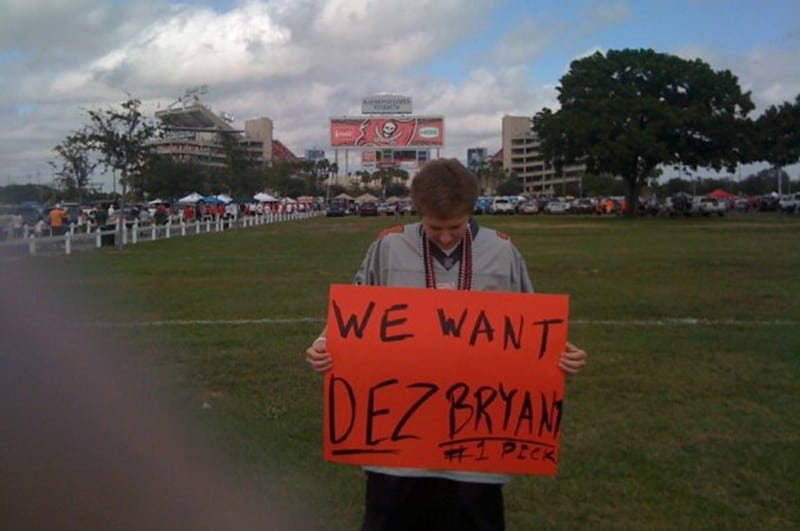All Twenty-Tuesday
Let’s start off with what you would call the Bucs’ “bread and butter” of a red zone play.
If you single cover Mike Evans, that’s where the ball is going – end of story. The Bucs are going to take their chances on the more difficult fade route, out route or just vertical route, which is something that puts a heavy burden on the quarterback to place the ball in a pin-point location. This also gives a player like the 6-foot-5 Evans a distinct advantage because of his height and reach over most smaller cornerbacks.
Routes that emphasize the ball going to the boundary take precision and timing. These kinds of routes can have success, as seen above, but they are the more difficult form of a red zone throw.
The reason why even some of the best offensive minds in the league can get stumped in the red zone comes from the nature of the position on the field. Outside of the red zone, a defense has to worry about covering a lot more yardage. That usually means that cornerbacks are less physical at the line of scrimmage, by nature, and that the safeties behind them can’t be as confident to help on shorter routes.
In the red zone, with less space to cover, defenders can get more aggressive. On the flip side, the offense is at a disadvantage because it can’t manipulate space nearly as much. The middle of the field often becomes more cluttered, the cornerbacks on the outside can use the sidelines and back of the end zone as an “extra defender” and thus offensive coordinators have to get creative in coming up with play designs that target the middle of the field either for a run or a pass – it’s tough to do.
Those play designs can come from a variety of different formations, but no matter the formation, concepts are generally placed into two categories: man beaters and zone beaters
Man Beaters
A little trick to use when trying to best man coverage in the red zone is when you start in one formation and switch to another completely in the pre-snap. As you can see above, the Eagles used pre-snap movement to get Washington to expose who was on who in man coverage. After the movement, they knew that one of the linebackers was on their running back, and that he likely wouldn’t be able to reach him on a quick throw. That theory was correct and the Eagles ended up with six easy points.
Another tip here is that when you have pre-snap movement and get the feeling the defense is caught off guard or just might be indecisive in who is covering who, quick throws can be your friend.
Another one of my favorite ways to beat man coverage in the red zone is with momentum. Anytime you can create chaos with a bunch of moving pieces running simple route concepts like we saw the Bucs do against the Dolphins above, you’re going to have a chance at success.
The play above was successful by the pass going to O.J. Howard simply because defenders cannot cover that long. The more time you make defenders run and cover momentum routes like we saw above, the better chance you have at one of your players getting open. If you run that play back a couple of times, Jackson was open in the end zone on the left side, as well. The routes were simple and they were fast. Multiple options would have scored there. I like keeping it moving and keeping it simple against man coverage.
In the play above, the Lions dropped their linebackers into zones, so it wasn’t total man coverage, but the way the play succeeded was because the Saints set up their fastest player to go on a dig route (momentum route) against a man coverage defensive back with chaos he had to navigate through all around him. Imagine the Bucs sending Jackson in that role. They need more of that in 2018.
As successful as Evans can be with fade routes to the sideline, Jackson is the Bucs’ easiest man beater in the red zone. If you can get him, his quick feet and his long speed on momentum routes that give Winston the option to throw it quick or let Jackson out run people horizontally, that’s the easiest way to having success between the 20 and 10 yard lines. The narrative with Jackson is that he can stretch the field with his speed when he can run vertically. That speed doesn’t go away in the red zone. Just have it start horizontally and not vertically and Jackson can be just as successful.
The Bucs don’t have to make Winston complete high difficulty throws in the red zone, even if that is what their best receiver does. With guys like Drew Brees, Tom Brady Carson Wentz, the reason why it seemed like their stats made it easy is because their offensive designers really did make it easy with plays and concepts like the one above – one the Bucs have a very ideal player to run.
Zone Beaters
It’s hard to ask your defense to play man coverage in the red zone if you don’t have the cornerbacks that a team like Jacksonville does where you know a team’s outside receiver isn’t going to have a complete advantage. So instead, defenses often opt to play some form of zone coverage once offenses get in the red zone, since, as stated before, they can use the back of the end zone as an extra zone defender.
A way that offenses can counter that is by having layered route combinations over a certain potion of the field. This kind of stuff only really works from the 20-15 yard line, since anything closer than that might make things too tight in terms of vertical layers, but from that distance it can yield good results, as shown above.
If you’re the quarterback, you have to be able to identify where a tough decision has to be made by a player in zone coverage and exploit it. In the play above, it was the safety who had to choose between either guarding the back of the end zone or stepping up and covering the receiver doing a comeback right in the middle at the 10-yard line. That play started with good design. It was a bunch formation to the right to thin out the middle of the field, it was the running back running to the left side and forcing the only linebacker remaining to go cover him, and that’s when the decision was forced on the safety.
The safety actually made the right choice and forced the tougher throw, but as the defender guarding the receiver in the end zone had his back to the ball, it was a completion and six points. Layered routes work really well from distances of 20-15 yards against zone coverage when they’re designed well enough to force a defender to make a tough decision, but it ultimately falls on the quarterback who has to see that.
Another way to best zone coverage around the 20 yard line is with a seam route. This is where tight ends have taken the NFL by storm. These kinds of routes are so tough to stop because normally you’re pairing them with some sort of movement by a running back or another receiver to where a linebacker can’t get quite deep enough and a safety can’t quite make a decision fast enough.
Seam concept hot reads are used all over the field, and that’s still true right on the edge of the red zone (and might even be the sweet spot for the route). There might not be a team in the league that knows that more than the Bucs.
Cam Brate could thank this route for the big contract extension he just signed. It is such a signature to his game, and that kind of route is so prevalent to scoring in the red zone in today’s NFL. When it comes to scoring in the red zone and how the Bucs can improve, there isn’t much room for improvement with Brate, and I mean that in the best way. They’re utilizing him very well, and his success rate on routes like the one above as a zone beater is up there with any other tight end in the league.
Something I would love to see the Buccaneers do more of, especially with their two tight ends, is something that the Eagles did a lot last year and that’s flooding one area of the field from within the 10 yard line and, again, forcing a tough decision for one player, often leaving at least one open.
In the play above, movement in the pre-snap allowed the quarterback Wentz to see the shift in the zone and gave away that it wasn’t man coverage. He then took a look at the defensive alignment and knew where his throw was going to go based off one defender. Once the defender knew what was going on, it was too late. The throw was quick and precise.
Flooding an area with quick passing options at the snap within the 10-yard line was something I saw the Eagles do a lot of when I was watching their tape this week. They constantly put zone defenses in tough positions in the red zone, and were able to make life tough on them even without the space.
But, I think that’s where Monken, Bajakian, Winston and the rest of the offense is right when they say they just haven’t been doing what they’ve needed to do. Bajakian was correct. The Bucs are still doing a lot of what the more successful red zone teams in the NFL are doing. Maybe not as much as they should be, as I would argue that Jackson’s use as a man beater and the double tight ends working close together flooding zones need to be more emphasized in the play calls in 2018. But, as a whole, the play designs do exist somewhere in the playbook.
If you’ll notice, though, many of the Eagles and Saints’ successful play calls in the red zone came from their quarterback knowing exactly where the ball need to go and very quickly. A successful red zone offense is built in the film room the week before the game even kicks off. It’s about a quarterback understanding what a defense is going to do and how he can manipulate it best. Sometimes that requires very quick decisions.
That’s where Winston comes in.
That’s the next step – a required step – in 2018.
Think fast, throw fast, throw accurately in the red zone.
Trevor Sikkema is the Tampa Bay Buccaneers beat reporter and NFL Draft analyst for PewterReport.com. Sikkema, an alumnus of the University of Florida, has covered both college and professional football for much of his career. As a native of the Sunshine State, when he's not buried in social media, Sikkema can be found out and active, attempting to be the best athlete he never was. Sikkema can be reached at: [email protected]



